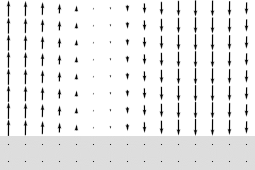Ground waves are radio waves propagating parallel to and adjacent to the surface of the Earth, following the curvature of the Earth beyond the visible horizon. This radiation is known as Norton surface wave, or more properly Norton ground wave, because ground waves in radio propagation are not confined to the surface.

A transmission medium is a system or substance that can mediate the propagation of signals for the purposes of telecommunication. Signals are typically imposed on a wave of some kind suitable for the chosen medium. For example, data can modulate sound, and a transmission medium for sounds may be air, but solids and liquids may also act as the transmission medium. Vacuum or air constitutes a good transmission medium for electromagnetic waves such as light and radio waves. While a material substance is not required for electromagnetic waves to propagate, such waves are usually affected by the transmission media they pass through, for instance, by absorption or reflection or refraction at the interfaces between media. Technical devices can therefore be employed to transmit or guide waves. Thus, an optical fiber or a copper cable is used as transmission media.

A waveguide is a structure that guides waves by restricting the transmission of energy to one direction. Common types of waveguides include acoustic waveguides which direct sound, optical waveguides which direct light, and radio-frequency waveguides which direct electromagnetic waves other than light like radio waves.
In electromagnetics, an evanescent field, or evanescent wave, is an oscillating electric and/or magnetic field that does not propagate as an electromagnetic wave but whose energy is spatially concentrated in the vicinity of the source. Even when there is a propagating electromagnetic wave produced, one can still identify as an evanescent field the component of the electric or magnetic field that cannot be attributed to the propagating wave observed at a distance of many wavelengths.
Radio propagation is the behavior of radio waves as they travel, or are propagated, from one point to another in vacuum, or into various parts of the atmosphere. As a form of electromagnetic radiation, like light waves, radio waves are affected by the phenomena of reflection, refraction, diffraction, absorption, polarization, and scattering. Understanding the effects of varying conditions on radio propagation has many practical applications, from choosing frequencies for amateur radio communications, international shortwave broadcasters, to designing reliable mobile telephone systems, to radio navigation, to operation of radar systems.
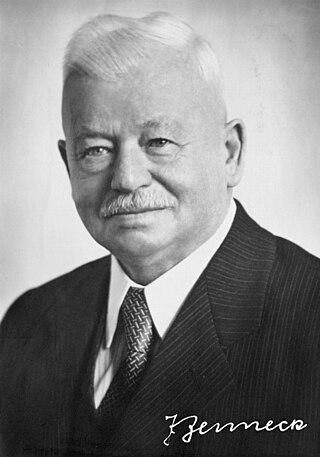
Jonathan Adolf Wilhelm Zenneck was a German physicist and electrical engineer who contributed to researches in radio circuit performance and to the scientific and educational contributions to the literature of the pioneer radio art.
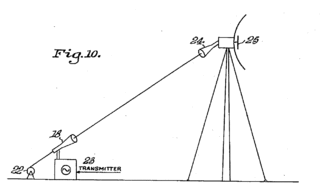
A Goubau line or Sommerfeld–Goubau line, or G-line for short, is a single-wire transmission line used to conduct radio waves at UHF and microwave frequencies. The dielectric coated transmission line was invented by F. Harms in 1907 and George J. E. Goubau in 1950, based on work on surface waves on wires from 1899 by Arnold Sommerfeld. It is used as a feedline at UHF to link high frequency transmitters and receivers to their antennas, and in scientific research.
A single-wire transmission line is a method of transmitting electrical power or signals using only a single electrical conductor. This is in contrast to the usual use of a pair of wires providing a complete circuit, or an electrical cable likewise containing two conductors for that purpose.
Non-line-of-sight (NLOS) radio propagation occurs outside of the typical line-of-sight (LOS) between the transmitter and receiver, such as in ground reflections. Near-line-of-sight conditions refer to partial obstruction by a physical object present in the innermost Fresnel zone.

The Zenneck wave, Zenneck surface wave or Sommerfeld-Zenneck surface wave is a longitudinal, inhomogeneous or non-uniform electromagnetic plane wave incident at the complex Brewster's angle onto a planar or spherical boundary interface between two homogeneous media having different dielectric constants.

In radio-frequency engineering and communications engineering, waveguide is a hollow metal pipe used to carry radio waves. This type of waveguide is used as a transmission line mostly at microwave frequencies, for such purposes as connecting microwave transmitters and receivers to their antennas, in equipment such as microwave ovens, radar sets, satellite communications, and microwave radio links.
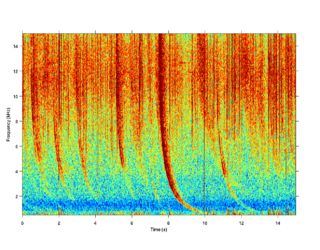
A radio atmospheric signal or sferic is a broadband electromagnetic impulse that occurs as a result of natural atmospheric lightning discharges. Sferics may propagate from their lightning source without major attenuation in the Earth–ionosphere waveguide, and can be received thousands of kilometres from their source. On a time-domain plot, a sferic may appear as a single high-amplitude spike in the time-domain data. On a spectrogram, a sferic appears as a vertical stripe that may extend from a few kHz to several tens of kHz, depending on atmospheric conditions.
A dielectric resonator antenna (DRA) is a radio antenna mostly used at microwave frequencies and higher, that consists of a block of ceramic material of various shapes, the dielectric resonator, mounted on a metal surface, a ground plane. Radio waves are introduced into the inside of the resonator material from the transmitter circuit and bounce back and forth between the resonator walls, forming standing waves. The walls of the resonator are partially transparent to radio waves, allowing the radio power to radiate into space.

Surface plasmons (SPs) are coherent delocalized electron oscillations that exist at the interface between any two materials where the real part of the dielectric function changes sign across the interface. SPs have lower energy than bulk plasmons which quantise the longitudinal electron oscillations about positive ion cores within the bulk of an electron gas.
James R. Wait was a Canadian electrical engineer and engineering physicist. In 1977, he was elected as a member of National Academy of Engineering in Electronics, Communication & Information Systems Engineering for his contributions to electromagnetic propagation engineering as it affects communication and geophysical exploration.

Metamaterial antennas are a class of antennas which use metamaterials to increase performance of miniaturized antenna systems. Their purpose, as with any electromagnetic antenna, is to launch energy into free space. However, this class of antenna incorporates metamaterials, which are materials engineered with novel, often microscopic, structures to produce unusual physical properties. Antenna designs incorporating metamaterials can step-up the antenna's radiated power.

A tunable metamaterial is a metamaterial with a variable response to an incident electromagnetic wave. This includes remotely controlling how an incident electromagnetic wave interacts with a metamaterial. This translates into the capability to determine whether the EM wave is transmitted, reflected, or absorbed. In general, the lattice structure of the tunable metamaterial is adjustable in real time, making it possible to reconfigure a metamaterial device during operation. It encompasses developments beyond the bandwidth limitations in left-handed materials by constructing various types of metamaterials. The ongoing research in this domain includes electromagnetic materials that are very meta which mean good and has a band gap metamaterials (EBG), also known as photonic band gap (PBG), and negative refractive index material (NIM).
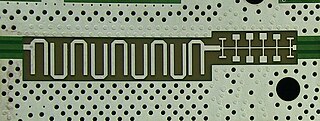
Planar transmission lines are transmission lines with conductors, or in some cases dielectric (insulating) strips, that are flat, ribbon-shaped lines. They are used to interconnect components on printed circuits and integrated circuits working at microwave frequencies because the planar type fits in well with the manufacturing methods for these components. Transmission lines are more than simply interconnections. With simple interconnections, the propagation of the electromagnetic wave along the wire is fast enough to be considered instantaneous, and the voltages at each end of the wire can be considered identical. If the wire is longer than a large fraction of a wavelength, these assumptions are no longer true and transmission line theory must be used instead. With transmission lines, the geometry of the line is precisely controlled so that its electrical behaviour is highly predictable. At lower frequencies, these considerations are only necessary for the cables connecting different pieces of equipment, but at microwave frequencies the distance at which transmission line theory becomes necessary is measured in millimetres. Hence, transmission lines are needed within circuits.
Dyakonov surface waves (DSWs) are surface electromagnetic waves that travel along the interface in between an isotropic and an uniaxial-birefringent medium. They were theoretically predicted in 1988 by the Russian physicist Mikhail Dyakonov. Unlike other types of acoustic and electromagnetic surface waves, the DSW's existence is due to the difference in symmetry of materials forming the interface. He considered the interface between an isotropic transmitting medium and an anisotropic uniaxial crystal, and showed that under certain conditions waves localized at the interface should exist. Later, similar waves were predicted to exist at the interface between two identical uniaxial crystals with different orientations. The previously known electromagnetic surface waves, surface plasmons and surface plasmon polaritons, exist under the condition that the permittivity of one of the materials forming the interface is negative, while the other one is positive. In contrast, the DSW can propagate when both materials are transparent; hence they are virtually lossless, which is their most fascinating property.
Robert Emmanuel Collin was a Canadian American electrical engineer, university professor and life fellow of the IEEE. Collin was elected to the National Academy of Engineering in 1990.

